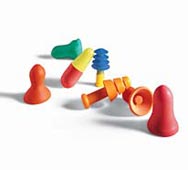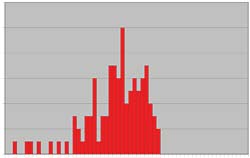
Putting the Personal Back into PPE: Hearing Protector Effectiveness
When program factors were evaluated to predict a good ear plug fit, one stood out distinctly with a strong correlation: one-on-one training.
FOR decades, studies in the workplace have shown hearing protectors to be underperformers: Real-world attenuation (noise blocking) is less than the published Noise Reduction Rating (NRR) for many workers. Studies like these have spawned a variety of de-rating schemes for hearing protectors that are often misunderstood or misapplied, such as the 50 percent OSHA de-rating or the NIOSH 75/50/30 percent de-rating for ear muffs, formable ear plugs, and pre-molded ear plugs, respectively.
But more recent studies offer some good news: A significant core of workers achieve good attenuation. For these users, the ear plugs are working! Now, we know many of the factors that cause a bad fit of a hearing protector--lack of training, shallow insertion, intentional compromise of the fit, to name a few. But what factors can predict a good fit in the field?
Field Attenuation of Ear Plugs
A field attenuation test was performed in 2007 by the Howard Leight Acoustical Test Lab on more than 100 workers at eight different facilities during their standard work shifts. Locations and workers were not pre-screened, and workers were tested with their own ear plugs they routinely wear on the job, with no modifications. The tested ear plugs were from four different manufacturers. Workers received no training or coaching as part of the test but were simply asked to insert the ear plugs as they normally do on the job. No feedback or correction was offered if they fitted the ear plug incorrectly.
Figure 1 shows a bar chart of results for the 100 workers and their variation from the published NRR [at the 0 dB on the vertical axis]. Nearly one-third of the workers achieved higher attenuation than the published NRR for their particular ear plug (shown by the bars above the 0 dB axis). About one-third were within 5 dB below the published NRR (shown by the bars between the 0 dB axis and -5 dB). And about one-third of the workers had attenuation that was more than 5 dB below the published NRR.

This chart shows the danger in using de-rating policies such as the oft-misapplied 50 percent de-rating. If a safety manager were to summarily assume that all ear plugs achieve only half of their published NRR in the field, then clearly two-thirds of the workers in this study would be seriously overprotected because they are achieving much higher protection than 50 percent.
Figure 1. Bar chart showing field attenuation of 100 workers.
Data
collected at eight facilities in 2007 by
the Howard Leight Acoustical
Test Lab.
Likewise, these results should remind safety managers that the published NRR is simply a laboratory estimate of the protection achievable when the ear plug is properly fit. Whether a particular user falls near the top or the bottom of that bar chart depends on a number of factors.
Predictors of Good Performance
What are the best predictors of a worker's achieving good attenuation from an ear plug? A variety of personal as well as program factors were evaluated to determine which factors would correlate the best to a good ear plug fit among these 100 workers. The table below shows the outcome:
There were no personal factors that were accurate predictors of a good fit of an ear plug in the field: Gender, age, years in noise, ear canal size, familiarity with product, and the model of ear plug were simply not good predictors of whether a user would achieve good attenuation.
Factors Influencing Good Ear Plug Fit |
No Effect
- Gender
- Age
- Years in noise
- Ear canal size
- Familiarity
- Model of ear plug
- Group training |
Positive Effect
+ Individual training
-/+ Enforcement |
When program factors were evaluated to predict a good ear plug fit, there was one factor that stood out distinctly with a strong correlation: one-on-one training. That is, the more often a worker had received individual training in the proper use of hearing protectors, the higher the probability of a good fit. The same could not be said for group training; it appeared to make no difference at all whether a worker had attended zero, five, or 10 group training sessions in hearing protection, when measuring good attenuation in the field. (There are other good reasons to offer group training in a Hearing Conservation Program, but group training is not the best method for teaching hearing protector fitting procedures.)
Enforcement was also a good predictor of good ear plug performance, but only when it was coupled with one-on-one training. When strong enforcement policies were in place without proper training, workers were actually more likely to have a poor fit than a good fit.
Improving the Personal Attenuation Rating
If a worker achieves low attenuation with one type of earplug, will he/she obtain low attenuation with all types of ear plugs? In other words, is a bad apple always a bad apple when it comes to ear plug users? We tested this by inviting some workers to try a second pair of ear plugs--different ear plugs, perhaps a model they had never tried before. Workers who tried a second pair of ear plugs often had major leaps in attenuation, bringing them closer to the published NRR, as shown in Figure 2.

Figure 2. Change in protection among workers with low attenuation. Data collected at eight facilities in 2007 by the Howard Leight Acoustical Test Lab.
This information confirms the wisdom in offering a variety of suitable hearing protectors to noise-exposed workers. Some workers are simply never going to achieve satisfactory results with one particular style of ear plug. If that ear plug is the only choice offered at the work site, some workers are destined for perpetual under-protection. Simply offering a second choice of suitable ear plugs significantly increases the prospects of achieving adequate attenuation.
Summary
The lessons learned from this field study of hearing protector attenuation can be distilled for the safety manager into two recommendations: 1) One-on-one training is the best predictor of whether workers will achieve a good fit with their ear plug. While the sheer volume of individual training may appear overwhelming in some facilities, the results were significant and measurable in terms of protecting hearing. 2) If a worker obtains a poor fit with a particular style of ear plug, trying a different pair of ear plugs typically achieves an acceptable attenuation. But even if the different ear plugs do not provide proper fit, the employer still has the option of fitting ear muffs to that worker.
Field testing of hearing protectors bridges the gap between the laboratory estimates of attenuation and the real-world attenuation achieved by workers as they normally wear the protectors. But most importantly, it restores the personal back into Personal Protective Equipment. And when it comes to hearing protection, achieving good protection is all personal.
This article originally appeared in the June 2007 issue of Occupational Health & Safety.